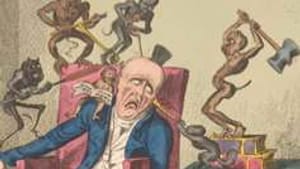Stay in the Loop
BSR publishes on a weekly schedule, with an email newsletter every Wednesday and Thursday morning. There’s no paywall, and subscribing is always free.
When the Prince of Wales was the Prince of Whales
Five centuries of caricatures at the Met in New York

As its title promises, "Infinite Jest" covers a great deal of ground from Renaissance Italy to present-day New York City. But this engaging and thorough exhibition seems at its mean-spirited best during the 18th and 19th Century periods, when newspapers and journals were ascendant and a good caricaturist was, like Sweeney Todd, "a proper artist with a knife," and sometimes a gun-for-hire as well.
Perhaps because the 18th Century set such store by Reason, it was especially painful for a man to be publicly branded as an idiot, or worse. Thus the recently defeated Whig Party could be treated as a latter-day herd of Gadarene Swine, being driven into the sea by the victorious King George III, while his successor George IV, as Prince of Wales, could be rendered literally by George Cruikshank as "the Prince of Whales," ogling a pair of mermaids with the faces of his mistresses, while spraying the victorious Tories with the "Dew of Favor," but showering defeated Whigs with the "Liquor of Oblivion."
Another word for dolt
Then as now, caricaturists employed a sort of visual shorthand, demonizing their targets with faint effort. Thus the British satirists routinely depicted Napoleon as a tiny man in a resplendent blue-and-gold uniform, wearing an oversized general's hat topped with plumes.
The French outdid the British by depicting their citizen-king, Louis Philippe, as a pear, the French slang for a dolt. Charles Philipon got this particular ball rolling by doing a series of drawings in which Louis Philippe's jowly, mutton-chopped visage gradually morphs into that a pear with human features. Louis was so unamused by this exercise of artistic license that he had Philipon jailed and then had his handpicked legislature pass a law literally making it a crime to hold the king or his ministers up to ridicule by word or image— a law that the Tammany Hall kingpin William "Boss" Tweed must have regarded longingly as he writhed under Thomas Nast's pen-and-ink scourging.
Lafayette skewered
But mere laws never stopped determined satirists. The aging Marquis de Lafayette was no longer a government minister, and if Honoré Daumier chose to depict him suffering a nightmare in which— with a tip of the hat to the Romantic artist Henry Fuseli— a huge pear, rather than a demon, presses down on his chest, who could prove that the pear was the hated king, whose Machiavellian rise the aging and deluded revolutionary hero had abetted?
The art of caricature may have originated as a simple (and apolitical) artist's exercise in heightening prominent facial features for an artistic effect. But political passions soon transformed it into a weapon too good to resist. When we bemoan the loss of civility in our current political discourse, along comes a show like "Infinite Jest" to remind us that "the kids are all right"— or all wrong.
Perhaps because the 18th Century set such store by Reason, it was especially painful for a man to be publicly branded as an idiot, or worse. Thus the recently defeated Whig Party could be treated as a latter-day herd of Gadarene Swine, being driven into the sea by the victorious King George III, while his successor George IV, as Prince of Wales, could be rendered literally by George Cruikshank as "the Prince of Whales," ogling a pair of mermaids with the faces of his mistresses, while spraying the victorious Tories with the "Dew of Favor," but showering defeated Whigs with the "Liquor of Oblivion."
Another word for dolt
Then as now, caricaturists employed a sort of visual shorthand, demonizing their targets with faint effort. Thus the British satirists routinely depicted Napoleon as a tiny man in a resplendent blue-and-gold uniform, wearing an oversized general's hat topped with plumes.
The French outdid the British by depicting their citizen-king, Louis Philippe, as a pear, the French slang for a dolt. Charles Philipon got this particular ball rolling by doing a series of drawings in which Louis Philippe's jowly, mutton-chopped visage gradually morphs into that a pear with human features. Louis was so unamused by this exercise of artistic license that he had Philipon jailed and then had his handpicked legislature pass a law literally making it a crime to hold the king or his ministers up to ridicule by word or image— a law that the Tammany Hall kingpin William "Boss" Tweed must have regarded longingly as he writhed under Thomas Nast's pen-and-ink scourging.
Lafayette skewered
But mere laws never stopped determined satirists. The aging Marquis de Lafayette was no longer a government minister, and if Honoré Daumier chose to depict him suffering a nightmare in which— with a tip of the hat to the Romantic artist Henry Fuseli— a huge pear, rather than a demon, presses down on his chest, who could prove that the pear was the hated king, whose Machiavellian rise the aging and deluded revolutionary hero had abetted?
The art of caricature may have originated as a simple (and apolitical) artist's exercise in heightening prominent facial features for an artistic effect. But political passions soon transformed it into a weapon too good to resist. When we bemoan the loss of civility in our current political discourse, along comes a show like "Infinite Jest" to remind us that "the kids are all right"— or all wrong.
What, When, Where
"Infinite Jest: Caricature and Satire from Leonardo to Levine." Through March 4, 2012 at the Metropolitan Museum of Art, 1000 Fifth Avenue (at 82nd St.), New York. (212) 535-7710 or www.metmuseum.org.
Sign up for our newsletter
All of the week's new articles, all in one place. Sign up for the free weekly BSR newsletters, and don't miss a conversation.